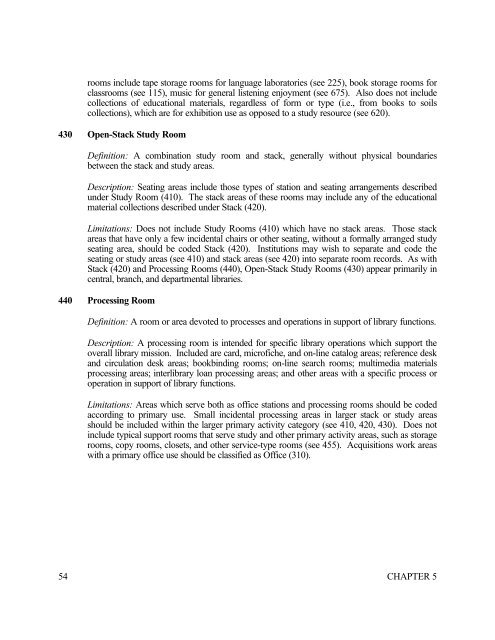Room Use Codes & Definitions
Room Use Codes & Definitions
Room Use Codes & Definitions
You also want an ePaper? Increase the reach of your titles
YUMPU automatically turns print PDFs into web optimized ePapers that Google loves.
ooms include tape storage rooms for language laboratories (see 225), book storage rooms forclassrooms (see 115), music for general listening enjoyment (see 675). Also does not includecollections of educational materials, regardless of form or type (i.e., from books to soilscollections), which are for exhibition use as opposed to a study resource (see 620).430 Open-Stack Study <strong>Room</strong>Definition: A combination study room and stack, generally without physical boundariesbetween the stack and study areas.Description: Seating areas include those types of station and seating arrangements describedunder Study <strong>Room</strong> (410). The stack areas of these rooms may include any of the educationalmaterial collections described under Stack (420).Limitations: Does not include Study <strong>Room</strong>s (410) which have no stack areas. Those stackareas that have only a few incidental chairs or other seating, without a formally arranged studyseating area, should be coded Stack (420). Institutions may wish to separate and code theseating or study areas (see 410) and stack areas (see 420) into separate room records. As withStack (420) and Processing <strong>Room</strong>s (440), Open-Stack Study <strong>Room</strong>s (430) appear primarily incentral, branch, and departmental libraries.440 Processing <strong>Room</strong>Definition: A room or area devoted to processes and operations in support of library functions.Description: A processing room is intended for specific library operations which support theoverall library mission. Included are card, microfiche, and on-line catalog areas; reference deskand circulation desk areas; bookbinding rooms; on-line search rooms; multimedia materialsprocessing areas; interlibrary loan processing areas; and other areas with a specific process oroperation in support of library functions.Limitations: Areas which serve both as office stations and processing rooms should be codedaccording to primary use. Small incidental processing areas in larger stack or study areasshould be included within the larger primary activity category (see 410, 420, 430). Does notinclude typical support rooms that serve study and other primary activity areas, such as storagerooms, copy rooms, closets, and other service-type rooms (see 455). Acquisitions work areaswith a primary office use should be classified as Office (310).54 CHAPTER 5
















